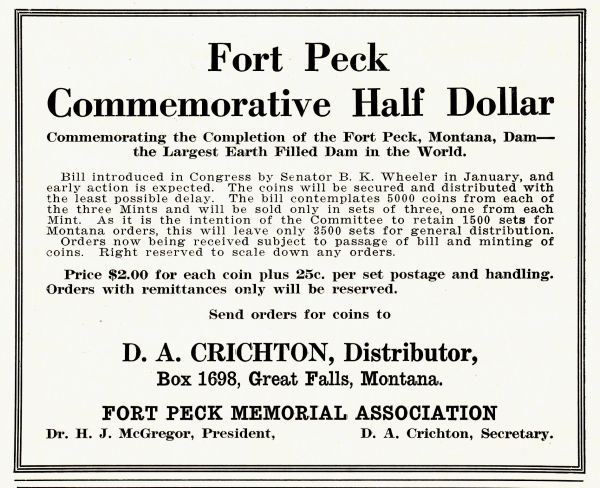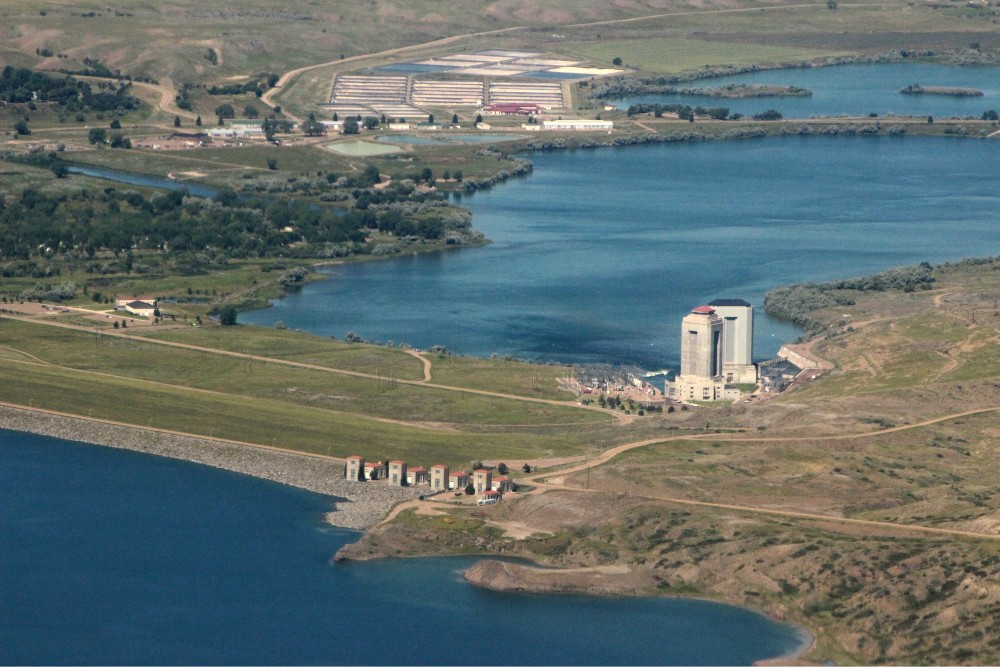Due to premature advertising, the Fort Peck Half Dollar is likely the most well-known "failed" US commemorative coin proposal. Here's its story...
Construction of the world's largest (at the time) earthen dam near the site of the old trading post - Fort Peck - in Montana was the catalyst for a commemorative half dollar bill introduced in the Senate by Burton Kendall Wheeler (D-MT) in January 1937; Mr. Wheeler was in his third (of four) terms as a Senator from Montana. Upon its introduction, the bill was referred to the Senate Committee on Banking and Currency.
Construction on Fort Peck Dam began in 1933 and was completed in 1940; it began to generate hydroelectric power in 1943. At the height of its construction activities in 1946, the project employed close to 11,000 people. When it was completed, Fort Peck Dam was the Largest earth-filled dam in the world. The dam Is 250 feet tall and 21,026 feet long. The dam "consists of an earthen embankment, an outlet tunnel for releasing stored water, two powerhouses, and 16 gates on a concrete-lined spillway to the west of the dam." (www.nwo.usace.army.mil/Missions/Dam-and-Lake-Projects/Missouri-River-Dams/Fort-Peck/).
"The U.S. Army Corps of Engineers has been operating Fort Peck Dam since 1940. Stretching across the upper Missouri River in northeastern Montana, it is the furthest upstream of six dam and reservoir projects built on the mainstem of the upper Missouri River. As part of a system of federal and private levees, these and other dams on the river's tributaries reduce flood risks for urban and agricultural property and lives throughout the Missouri River watershed. When not operating to reduce flood impacts, USACE manages this mainstem system of dams to balance hydropower generation, water supply, water quality, irrigation, fish and wildlife conservation, navigation, and recreation benefits."
(www.nwo.usace.army.mil/Missions/Dam-and-Lake-Projects/Missouri-River-Dams/Fort-Peck/).
The bill's coin request was fairly modest - it called for the minting of up to 30,000 coins. An interesting wrinkle to the mintage request was the fact the bill specified that up to 5,000 coins were to be struck at each of the Mint facilities (Philadelphia, Denver and San Francisco), and that up to 15,000 coins were to be struck in 1937, with up to 15,000 more struck in 1938 - each batch was to be dated accordingly.
The coins were to have been struck for the Fort Peck Memorial Association, which was required to place orders for a minimum of 5,000 coins at a time. The Association was to buy the coins at par (i.e., face value) but had the authority to sell them at a premium. Net proceeds from coin sales were to go toward helping pay the expenses connected to the commemoration of the dam's construction/completion.
Considering the large number of commemorative coins approved by Congress in 1936, the Fort Peck Memorial Association was highly confident in its bill's passage. As such, they began to promote their coin, and placed an advertisement in the March 1937 issue of the
ANA's
The Numismatist to provide collectors with ordering details, including in-state vs. out-of-state distribution.
Fort Peck Dam Half Dollar Advertisement in The Numismatist (Image Credit: Fort Peck Memorial Association/American Numismatic Association. The Numismatist, March 1937. Fair use.)
(Image Credit: Fort Peck Memorial Association/American Numismatic Association. The Numismatist, March 1937. Fair use.)It was a different Congressional environment for US commemorative coins in 1937 vs. 1936, however, and it resulted in the Fort Peck bill never being reported out by the Committee. Ultimately, it died for lack of action. The Association did not give up easily, however, and even into the next Congress (1939) held out hope that it could get a coin approved. Eventually, it had to face reality and refund the money received from collectors who had responded to the Association's early advertising and sent in orders for the half dollar; many collectors waited years for their refund.
Fort Peck Dam Looking downstream on the Fort Peck dam including the earthen embankment; the power house surge tanks to the right; the interpretive center on the left side of the embankment; and in the distance, at the top of the photo is the state fish hatchery.(Image and Caption Credit: US Army Corps of Engineers, Northwestern Division web site. https://www.nwd.usace.army.mil/Medi...t-statement/ Public Domain.)
Looking downstream on the Fort Peck dam including the earthen embankment; the power house surge tanks to the right; the interpretive center on the left side of the embankment; and in the distance, at the top of the photo is the state fish hatchery.(Image and Caption Credit: US Army Corps of Engineers, Northwestern Division web site. https://www.nwd.usace.army.mil/Medi...t-statement/ Public Domain.)Here's a link to learn more about the Fort Peck Dam:
http://www.fortpeckdam.com/About 10 years ago, I had an initial look at this failed commemorative:
-
Did You Know #5 - Fort Peck Dam1937 also saw a coin proposal in recognition of the construction of the Booneville Dam. You can read about it here:
-
What If? 1937 Booneville Dam CompletionFor more of my topics on commemorative coins and medals, including other What If? stories, see:
Commems Collection.























